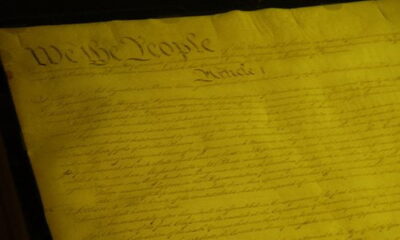

Features
Modern Magna Carta: Kyoto Protocol
In the lead up to the 800th Magna Carta Anniversary this year Ashley Summers takes a look at the original and a series of modern ‘versions’ of the Magna Carta from the US Constitution to the UN Declaration of Human Rights and various conventions on climate change and sustainability, Magna Carta for the Earth.
Adopted 11 December 1997 and finally entering into force 16 February 2005, the Kyoto Protocol is an international treaty that expands upon the 1992 United Nations Framework Convention on Climate Change (UNFCCC). The treaty acknowledges that global warming exists and is human-caused. There are currently 192 Parties to the Protocol, though Canada withdrew in December 2012 and it was never ratified by the US.
The Protocol’s objective was to implement the UNFCCC’s plan to fight global warming by effectively reducing greenhouse gas concentrations in the atmosphere. Article Two outlines such reductions to “a level that would prevent dangerous anthropogenic interference with the climate system.”
Much like the Montreal Protocol, which was the first internationally-ratified treaty, the Kyoto Protocol calls for international participation and awareness, though with heavier standards placed on more developed states, with “common, but differentiated responsibilities.” This means that the Protocol was designed to require nation-states in the Global North to take more responsibility for the damage already caused, as they were the main saboteurs, moving throughout 150 years of industrial activity.
With the world in its current precarious state, adherence and commitment to the treaty is paramount. Under the protocol, signatories are required to report their emission levels, providing transparency in outputs and aiming to stay under allowed maximums. The Protocol also has a designated trading policy that allows participatory nation-states to “trade” their emissions overflow to countries that did not exceed their maximums.
There is a very strict and comprehensive monitoring policy involved, recording annually-reported emission inventories. An international transaction log inventories of actual emissions and trade transactions is kept in Bonn, Germany. In addition to the registry systems that are in place, Parties must submit reports at regular intervals. There are compliance systems in place that ensure commitments are met, and support in adaptation measures, supporting countries who are already experiencing the adverse effects of human-caused climate change.
Photo: Martin Nikolaj Bech via Flickr
Further reading:
Modern Magna Carta: the original and still the best
Modern Magna Carta: Declaration of Human Rights
Modern Magna Carta: The European Convention on Human Rights
Prince Charles: climate agreement should be ‘new Magna Carta for the Earth’
Cameron, Clegg and Miliband sign joint climate change agreement


 Environment10 months ago
Environment10 months agoAre Polymer Banknotes: an Eco-Friendly Trend or a Groundswell?

 Environment12 months ago
Environment12 months agoEco-Friendly Home Improvements: Top 7 Upgrades for 2025

 Features9 months ago
Features9 months agoEco-Friendly Cryptocurrencies: Sustainable Investment Choices

 Features10 months ago
Features10 months agoEco-Friendly Crypto Traders Must Find the Right Exchange






























